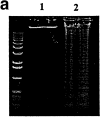Regulation of anti-DNA B cells in recombination-activating gene-deficient mice
- PMID: 9763604
- PMCID: PMC2212494
- DOI: 10.1084/jem.188.7.1247
Regulation of anti-DNA B cells in recombination-activating gene-deficient mice
Abstract
Anti-DNA antibodies are regulated in normal individuals but are found in high concentration in the serum of systemic lupus erythematosus (SLE) patients and the MRL lpr/lpr mouse model of SLE. We previously studied the regulation of anti-double-stranded (ds)DNA and anti-single-stranded (ss)DNA B cells in a nonautoimmune background by generating mice carrying immunoglobulin transgenes coding for anti-DNAs derived from MRL lpr/lpr. Anti-dsDNA B cells undergo receptor editing, but anti-ssDNA B cells seem to be functionally silenced. Here we have investigated how anti-DNA B cells are regulated in recombination- activating gene (RAG)-2-/- mice. In this setting, anti-dsDNA B cells are eliminated by apoptosis in the bone marrow and anti-ssDNA B cells are partially activated.
Figures












Similar articles
-
Anti-DNA B cells in MRL/lpr mice show altered differentiation and editing pattern.J Exp Med. 2002 Dec 16;196(12):1543-52. doi: 10.1084/jem.20021560. J Exp Med. 2002. PMID: 12486097 Free PMC article.
-
Somatic mutation and light chain rearrangement generate autoimmunity in anti-single-stranded DNA transgenic MRL/lpr mice.J Exp Med. 1999 Sep 6;190(5):691-704. doi: 10.1084/jem.190.5.691. J Exp Med. 1999. PMID: 10477553 Free PMC article.
-
Characterization of anti-single-stranded DNA B cells in a non-autoimmune background.J Immunol. 1997 Sep 15;159(6):2633-44. J Immunol. 1997. PMID: 9300682
-
Breakdown of B cell tolerance in a mouse model of systemic lupus erythematosus.J Exp Med. 1995 Mar 1;181(3):1157-67. doi: 10.1084/jem.181.3.1157. J Exp Med. 1995. PMID: 7532679 Free PMC article.
-
Self-reactive B cells in nonautoimmune and autoimmune mice.Immunol Res. 1998;17(1-2):49-61. doi: 10.1007/BF02786430. Immunol Res. 1998. PMID: 9479567 Review.
Cited by
-
Anti-DNA B cells in MRL/lpr mice show altered differentiation and editing pattern.J Exp Med. 2002 Dec 16;196(12):1543-52. doi: 10.1084/jem.20021560. J Exp Med. 2002. PMID: 12486097 Free PMC article.
-
Central tolerance regulates B cells reactive with Goodpasture antigen alpha3(IV)NC1 collagen.J Immunol. 2008 Nov 1;181(9):6092-100. doi: 10.4049/jimmunol.181.9.6092. J Immunol. 2008. PMID: 18941198 Free PMC article.
-
Central B-cell tolerance: where selection begins.Cold Spring Harb Perspect Biol. 2012 Apr 1;4(4):a007146. doi: 10.1101/cshperspect.a007146. Cold Spring Harb Perspect Biol. 2012. PMID: 22378602 Free PMC article.
-
Systemic Lupus Erythematosus: Definitions, Contexts, Conflicts, Enigmas.Front Immunol. 2018 Mar 1;9:387. doi: 10.3389/fimmu.2018.00387. eCollection 2018. Front Immunol. 2018. PMID: 29545801 Free PMC article.
-
Neutrophil extracellular chromatin traps connect innate immune response to autoimmunity.Semin Immunopathol. 2013 Jul;35(4):465-80. doi: 10.1007/s00281-013-0376-6. Epub 2013 Apr 18. Semin Immunopathol. 2013. PMID: 23595413 Review.
References
-
- Tan EM. Antinuclear antibodies: diagnostic markers and clues to the basis of systemic autoimmunity. Pediatr Infect Dis J. 1988;7:S3–S9. - PubMed
-
- Hardin JA. The lupus autoantigens and the pathogenesis of systemic lupus erythematosus. Arthritis Rheum. 1986;29:457–460. - PubMed
-
- Shlomchik MJ, Marshak-Rothstein A, Wolfowicz CB, Rothstein T, Weigert MG. The role of clonal selection and somatic mutation in autoimmunity. Nature. 1987;328:805–811. - PubMed
-
- Craft JE, Hardin JA. Linked sets of antinuclear antibodies: what do they mean? . J Rheumatol. 1987;14:106–109. - PubMed
Publication types
MeSH terms
Substances
Grants and funding
LinkOut - more resources
Full Text Sources
Molecular Biology Databases

